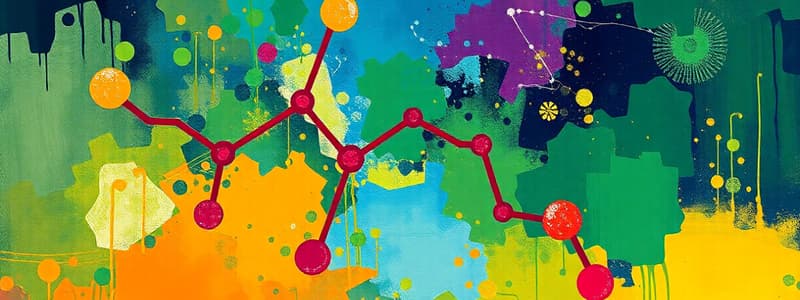Podcast
Questions and Answers
Which of the following responses is characteristic of muscarinic receptor activation?
Which of the following responses is characteristic of muscarinic receptor activation?
- Increased heart rate.
- Stimulation of sweat glands. (correct)
- Bronchodilation.
- Vasoconstriction in skeletal muscle.
A drug that activates both the parasympathetic and sympathetic nervous systems most likely acts on which type of receptor?
A drug that activates both the parasympathetic and sympathetic nervous systems most likely acts on which type of receptor?
- Beta-2 adrenergic receptors.
- Muscarinic receptors in smooth muscle.
- Muscarinic receptors in the heart.
- Nicotinic receptors at autonomic ganglia. (correct)
Which of the following is the primary mechanism by which pilocarpine reduces intraocular pressure in glaucoma?
Which of the following is the primary mechanism by which pilocarpine reduces intraocular pressure in glaucoma?
- Inhibiting the production of aqueous humor.
- Activating M3 muscarinic receptors on the ciliary muscle. (correct)
- Blocking beta-adrenergic receptors in the ciliary body.
- Dilating blood vessels in the retina.
What effect does activation of M2 receptors in the heart have on systemic circulation?
What effect does activation of M2 receptors in the heart have on systemic circulation?
Which of the following effects would be observed following activation of M3 receptors on bronchial smooth muscle?
Which of the following effects would be observed following activation of M3 receptors on bronchial smooth muscle?
Which of the following is a direct effect of nicotine on the cardiovascular system?
Which of the following is a direct effect of nicotine on the cardiovascular system?
In a tissue with both PSNS and SNS innervation, the predominant response to nicotine is typically:
In a tissue with both PSNS and SNS innervation, the predominant response to nicotine is typically:
Which of the following best describes the mechanism of action of indirect-acting cholinomimetics?
Which of the following best describes the mechanism of action of indirect-acting cholinomimetics?
What is the duration of action for reversible acetylcholinesterase inhibitors primarily determined by?
What is the duration of action for reversible acetylcholinesterase inhibitors primarily determined by?
Which of the following distinguishes irreversible AChE inhibitors, such as echothiophate, from reversible inhibitors like physostigmine?
Which of the following distinguishes irreversible AChE inhibitors, such as echothiophate, from reversible inhibitors like physostigmine?
What is the expected effect of physostigmine on heart rate, considering its mechanism of action?
What is the expected effect of physostigmine on heart rate, considering its mechanism of action?
Which of the following symptoms is NOT associated with muscarinic excess?
Which of the following symptoms is NOT associated with muscarinic excess?
Which receptor subtype is primarily found in the heart and mediates the decrease in heart rate upon activation?
Which receptor subtype is primarily found in the heart and mediates the decrease in heart rate upon activation?
Why are ganglionic blockers like trimethaphan rarely used clinically?
Why are ganglionic blockers like trimethaphan rarely used clinically?
Which of the following best describes the primary use of neuromuscular blockers like D-tubocurarine?
Which of the following best describes the primary use of neuromuscular blockers like D-tubocurarine?
Which medication, among the options provided, is an antagonist for muscarinic receptors?
Which medication, among the options provided, is an antagonist for muscarinic receptors?
Which of the following facilitates aqueous humor drainage in the eye is a function of which receptor?
Which of the following facilitates aqueous humor drainage in the eye is a function of which receptor?
How do the mechanisms of action differ between pilocarpine and physostigmine in the treatment of glaucoma?
How do the mechanisms of action differ between pilocarpine and physostigmine in the treatment of glaucoma?
Which cholinergic drug should be avoided in an individual diagnosed with glaucoma?
Which cholinergic drug should be avoided in an individual diagnosed with glaucoma?
A patient is experiencing bladder atony, due to abdominal surgery. Which cholinergic drug would be helpful in managing this condition?
A patient is experiencing bladder atony, due to abdominal surgery. Which cholinergic drug would be helpful in managing this condition?
Which of the following responses coincides with activation of nicotinic receptors on skeletal muscle?
Which of the following responses coincides with activation of nicotinic receptors on skeletal muscle?
In a patient presenting with symptoms of muscarinic excess due to possible mushroom poisoning, which of the following would be the MOST appropriate antidote?
In a patient presenting with symptoms of muscarinic excess due to possible mushroom poisoning, which of the following would be the MOST appropriate antidote?
A patient is administered nicotine, and they have increase of Acetylcholine (ACh) and Norepinephrine (NE). Which of the following location is being activated by nicotine?
A patient is administered nicotine, and they have increase of Acetylcholine (ACh) and Norepinephrine (NE). Which of the following location is being activated by nicotine?
If a toxin blocks acetylcholinesterase, amplifying ACh effects, where is the effect most similar to those seen with direct-acting cholinomimetic drugs?
If a toxin blocks acetylcholinesterase, amplifying ACh effects, where is the effect most similar to those seen with direct-acting cholinomimetic drugs?
A researcher is studying the effects of a new drug on vascular tone. The drug activates beta-2 receptors and blocks alpha-1 receptors in blood vessels. What would be the predicted net effect on blood pressure?
A researcher is studying the effects of a new drug on vascular tone. The drug activates beta-2 receptors and blocks alpha-1 receptors in blood vessels. What would be the predicted net effect on blood pressure?
Flashcards
Acetylcholine (ACh)
Acetylcholine (ACh)
Activates muscarinic and nicotinic receptors. Susceptible to acetylcholinesterase (AChE).
Bethanechol
Bethanechol
Activates muscarinic receptors, mimicking parasympathetic effects.
Muscarine
Muscarine
Activates muscarinic receptors, an alkaloid compound.
Pilocarpine
Pilocarpine
Signup and view all the flashcards
Nicotine
Nicotine
Signup and view all the flashcards
Physostigmine
Physostigmine
Signup and view all the flashcards
Echothiophate
Echothiophate
Signup and view all the flashcards
Atropine
Atropine
Signup and view all the flashcards
Trimethaphan
Trimethaphan
Signup and view all the flashcards
D-tubocurarine
D-tubocurarine
Signup and view all the flashcards
M3 Receptor
M3 Receptor
Signup and view all the flashcards
M2 Receptor
M2 Receptor
Signup and view all the flashcards
Glaucoma
Glaucoma
Signup and view all the flashcards
Miosis
Miosis
Signup and view all the flashcards
Bradycardia
Bradycardia
Signup and view all the flashcards
Bronchoconstriction
Bronchoconstriction
Signup and view all the flashcards
Lacrimation
Lacrimation
Signup and view all the flashcards
Urination
Urination
Signup and view all the flashcards
Carbamate ester
Carbamate ester
Signup and view all the flashcards
Organophosphate
Organophosphate
Signup and view all the flashcards
DUMBELS
DUMBELS
Signup and view all the flashcards
Nicotine effect on PSNS and SNS
Nicotine effect on PSNS and SNS
Signup and view all the flashcards
Study Notes
- Acetylcholine activates muscarinic and nicotinic receptors and is susceptible to acetylcholinesterase (AChE).
- Bethanechol, muscarine, and pilocarpine activate muscarinic receptors.
- Nicotine activates nicotinic receptors.
Indirect-Acting Agonists (AChE Inhibitors)
- Physostigmine is an indirect-acting agonist.
- Endothiophate is an indirect-acting agonist that has a long acting effect.
Antagonists
- Atropine is an antagonist for muscarinic receptors.
- Trimethaphan is an antagonist for nicotinic neurons.
- D-tubocurarine is an antagonist for nicotinic muscles.
Direct Receptor Agonists
- Esters of choline, like acetylcholine, activate both muscarinic and nicotinic receptors, while bethanechol activates only muscarinic receptors.
- These agonists aren't absorbed or distributed well in the body.
- Alkaloids such as muscarine, nicotine, and pilocarpine are absorbed and distributed well, even in the CNS.
- Muscarine affects muscles, nicotine targets nicotinic receptors and pilocarpine affects muscles.
- Most cholinergic receptor agonists used clinically aren't receptor subtype selective.
- Muscarinic receptor activation produces responses similar to parasympathetic nervous system (PSNS) activation, including effects on sweat glands.
- Endothelial-derived relaxation of blood vessels occurs even without acetylcholine release in the blood due to the presence of receptors.
- Nicotinic receptor activation stimulates both the PSNS and SNS, as well as skeletal muscle contraction.
- Nicotine initially stimulates and then blocks these receptors.
- M3 muscarinic receptors are present on smooth muscles, while M2 receptors are found in the heart.
Pilocarpine and Glaucoma
- Pilocarpine eye drops can treat glaucoma by reducing intraocular pressure.
- Pilocarpine, a direct muscarinic agonist, activates M3 receptors on the ciliary muscle, which contracts and widens the canal therefore promoting fluid drainage.
- It increases the drainage of aqueous humor out of the eye.
Systemic Circulation Effects of Pilocarpine
- In the heart, M2 receptors are activated, decreasing both the rate and force of contractions.
- In blood vessels, M3 receptors on endothelial cells are activated, stimulating vasodilation and increasing EDRH.
- In the bronchi, activation of M3 receptors on bronchial smooth muscle and mucous glands leads to bronchoconstriction and increased secretion.
Nicotinic Receptor Agonists and Effects
- They activate both PSNS and SNS and cause skeletal muscle contraction.
- They stimulate nicotinic receptors in the CNS.
- Nicotine activates both PSNS and SNS at the ganglia, increasing acetylcholine and norepinephrine in tissues and the adrenal gland.
- In most organ systems where the PSNS is dominant, the PSNS response is primarily observed when both systems are activated.
- Example: Nicotine increases smooth muscle contraction, motility, and gland secretion in the GI tract.
- In tissues lacking PSNS input, only the SNS response is observed such as vasoconstriction in organs and skin via α1 receptors and vasodilation in skeletal muscle via β2 receptors.
- Since vascular beds with α1 receptors outweigh those with β2, the net effect is vasoconstriction.
- The heart experiences an increased heart rate.
Indirect Acting Cholinomimetics
- These bind to acetylcholinesterase (AChE) to reduce acetylcholine hydrolysis subsequently increasing local acetylcholine concentration and amplifying its effects.
- The duration of action is determined by the drug-enzyme complex.
Reversible Inhibitors
- Carbamate esters (e.g., physostigmine) form a covalent bond with AChE that is somewhat resistant to hydration, with a half-life of 30 minutes to 6 hours but generally demonstrate poor absorption and distribution (except physostigmine).
Irreversible Inhibitors
- Organophosphates (e.g., echothiophate) form a stable covalent bond with AChE, lasting days to weeks, and are well-absorbed and distributed, even in the CNS.
- Action results in the amplification of endogenous acetylcholine, producing effects similar to direct-acting cholinomimetic drugs, but only where acetylcholine is released.
Effects of Increased Acetylcholine
- Increased acetylcholine at PSNS and SNS ganglia, tissues innervated by autonomic acetylcholine-releasing neurons, skeletal muscle, and in the CNS.
Tissue Specific Effects
- For most tissues, the PSNS effect is observed due to increased acetylcholine at both ganglia and effector cells due to increased ACh.
- Pilocarpine activates M2 receptors in the heart, decreasing rate and force of contraction. It also activates M3 and M5 receptors on endothelial cells, increasing EDRF, leading to vasodilation.
- Nicotine activates Nn receptors at PSNS and SNS ganglia and the adrenal gland. In blood vessels (SNS), it increases norepinephrine and epinephrine, causing α1 vasoconstriction in organs and skin and β2 vasodilation in skeletal muscle. In the heart, nicotine increases rate and force of contraction.
- Physostigmine inhibits AChE, increasing acetylcholine at ganglia and the adrenal gland, stimulating both PSNS and SNS. In blood vessels, it leads to α1 vasoconstriction and β2 vasodilation. In the heart, increased acetylcholine due to AChE inhibition decreases rate and force of contraction.
Toxicities Associated with Muscarinic Agonists
- Symptoms of muscarinic excess can result from ingesting mushrooms containing muscarine and pilocarpine overdose.
- Activation of muscarinic receptors in tissues/organs innervated by the PSNS, sweat glands, blood vessels (EDRF), and the CNS (excitation) leads to symptoms referred to as DUMBELS.
- Diarrhea results from activation of M3 receptors on smooth muscles causing contractions in the GI tract.
- Urination is increased due to contraction of the bladder wall.
- Miosis is the constriction of the pupil.
- Bradycardia is the contraction of smooth muscle where M3 receptors are located.
- Bronchoconstriction - contraction of bronchi
- Excitation will occur in the CNS
- Lacrimation is an increase from gland secretion due to M3 receptor activation.
- Sweating and Salivation also involve increased gland secretions due to M3 receptor activation.
- M3 receptors are most parts of the body, M2 receptors are heart specific, and the brain contains all muscarinic receptor subtypes.
Atropine
- Equal affinity for M receptor subtypes.
- Well absorbed and distributed, including in the CNS.
- It causes dilated pupils, achieved through eye drops.
Ganglionic Blockers
- Trimethaphan blocks the Nn subunit and is used for hypertensive crisis or dissecting aortic aneurysm, but is rarely used clinically due to effects on both PSNS and CNS.
Neuromuscular Blockers
- D-Tubocurarine is derived from an Amazon frog and used in surgical procedures to reduce skeletal muscle contraction.
Glaucoma Treatment
- Treatment includes pilocarpine, physostigmine, and echothiophate.
- These drugs decrease ocular pressure by opening the canal and contracting the ciliary muscle (activating M3 muscles), facilitating drainage.
- Pilocarpine is a muscarinic direct agonist that binds to and activates M3 receptors, while physostigmine inhibits AChE, increasing acetylcholine and M3 activation.
Cholinergic Drug to Avoid in Glaucoma
- Muscarinic receptor agonists like atropine should be avoided.
Bethanechol for Bladder Atony
- Bethanechol, a direct muscarinic agonist, activates M3 receptors in the bladder to contract smooth muscle and increase urination.
- Other drugs like muscarinic agonists and pilocarpine could also be used to increase acetylcholine levels.
Studying That Suits You
Use AI to generate personalized quizzes and flashcards to suit your learning preferences.





